第二组:metonymy,synecdoche
metonymy和synecdoche的例子
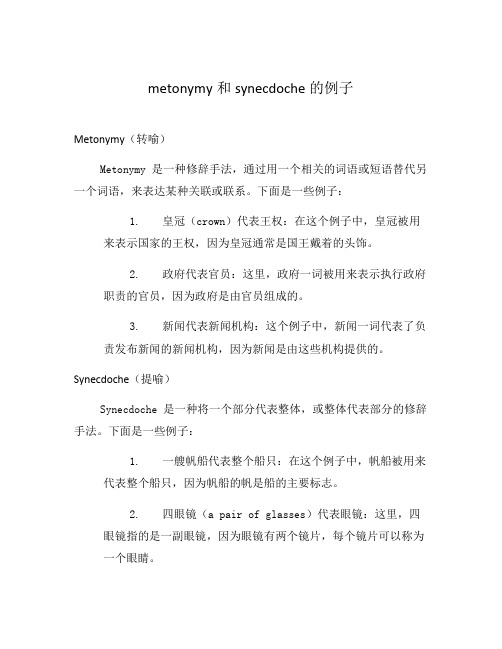
metonymy和synecdoche的例子
Metonymy(转喻)
Metonymy 是一种修辞手法,通过用一个相关的词语或短语替代另一个词语,来表达某种关联或联系。
下面是一些例子:
1.皇冠(crown)代表王权:在这个例子中,皇冠被用
来表示国家的王权,因为皇冠通常是国王戴着的头饰。
2.政府代表官员:这里,政府一词被用来表示执行政府
职责的官员,因为政府是由官员组成的。
3.新闻代表新闻机构:这个例子中,新闻一词代表了负
责发布新闻的新闻机构,因为新闻是由这些机构提供的。
Synecdoche(提喻)
Synecdoche 是一种将一个部分代表整体,或整体代表部分的修辞手法。
下面是一些例子:
1.一艘帆船代表整个船只:在这个例子中,帆船被用来
代表整个船只,因为帆船的帆是船的主要标志。
2.四眼镜(a pair of glasses)代表眼镜:这里,四
眼镜指的是一副眼镜,因为眼镜有两个镜片,每个镜片可以称为一个眼睛。
3.发动机代表整辆车:这个例子中,发动机代表了整辆
车,因为发动机是车辆运转的核心部分。
结论
Metonymy 和 Synecdoche 都是语言中丰富多彩的修辞手法,可以帮助我们更具表现力地表达观点和意思。
通过使用这些修辞手法,我们可以通过相关的表示方式来引发读者关联,并增加我们的语言表达的丰富性。
英语Metonymy_Synecdoche_省略_ntonomasia与汉语_借
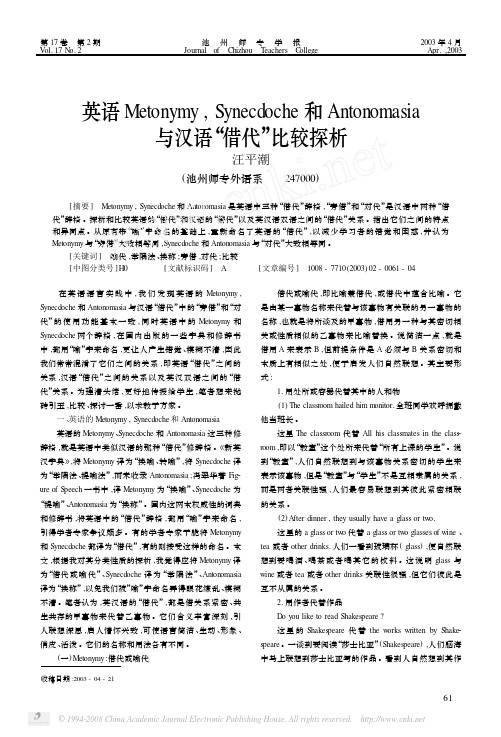
第17卷 第2期池州师专学报2003年4月V ol.17N o.2Journal of Chizhou T eachers C ollege Apr.,2003英语Metonymy,Synecdoche和Antonomasia与汉语“借代”比较探析汪平潮(池州师专外语系 247000)[摘要] Metonymy,Synecdoche和Antonomasia是英语中三种“借代”辞格,“旁借”和“对代”是汉语中两种“借代”辞格。
探析和比较英语的“借代”和汉语的“借代”以及英汉语双语之间的“借代”关系。
指出它们之间的特点和异同点。
从原有带“喻”字命名的基础上,重新命名了英语的“借代”,以减少学习者的错觉和困惑,并认为Metonymy与“旁借”大致相等同,Synecdoche和Antonomasia与“对代”大致相等同。
[关键词] 喻代,举隅法、换称;旁借,对代;比较[中图分类号]H0 [文献标识码] A [文章编号] 1008-7710(2003)02-0061-04 在英语语言实践中,我们发现英语的Metonymy, Synecdoche和Antonomasia与汉语“借代”中的“旁借”和“对代”的使用功能基本一致,同时英语中的Metonymy和Synecdoche两个辞格,在国内出版的一些字典和修辞书中,都用“喻”字来命名,更让人产生错觉、模糊不清,因此我们常常混淆了它们之间的关系,即英语“借代”之间的关系,汉语“借代”之间的关系以及英汉双语之间的“借代”关系。
为理清头绪,更好地传授给学生,笔者想来抛砖引玉,比较、探讨一番,以求教于方家。
一、英语的Metonymy,Synecdoche和Antonomasia英语的Metonymy、Synecdoche和Antonomasia这三种修辞格,就是英语中类似汉语的那种“借代”修辞格。
《新英汉字典》,将Metonymy译为“换喻、转喻”,将Synecdoche译为“举隅法、提喻法”,而未收录Antonomasia;冯翠华著Fig2 ure of S peech一书中,译Metonymy为“换喻”、Synecdoche为“提喻”、Antonomasia为“换称”。
英语修辞格Metonymy和Synecdoche的对比分析

- 88 -
语言学及应用语言学研究
代的关系,那么,它就容易与借代相混淆。所以学习提喻辞格我们首先碰到的一个问题 是如何能把提喻与借代区分开。凡研究过这两个辞格的人都知道这两种辞格很难区分开 来。但是,很难区分并非不能区分。(李鑫华,2000)
- 91 -
语 言 与 文 化 论 坛 2020 年( 第一辑)
综上所述,M 是一种修辞格,其中所说的事物不是直接说出来的,而是通过与之有 着不可分割关系的事物来表达的,即相似事物之间的类比,这不是一个同质的概念,而 是一个近似的概念。这两个概念紧密联系,相互依赖。M 强调的不是相似性,而是联 想。为了给读者或听众留下深刻印象,不仅要联想到正在写的东西,而且要联想到正在 说的东西的特点,如 White House 指的是美国总统府,而 No.10 Downing Street 则指的是 英国首相官邸。
M 是英语中最常见和最广泛使用的修辞格,对争论、解释,以及对人、事物、对象 等的描述中都是有用的。它的基本功能是使事物或人物具体化、生动化、形象化,使人 们能够看到、感受和理解,从而增强语言的说服力和感染力,具有具体化、形象化、含 蓄化、幽默化、讽刺化等功能。
2.2 特 点
M 包含本体和喻体,二者之间存在着借代关系。如:What is learned in the cradle is carried to the grave.(从摇篮里学到的东西会一直带到坟墓里。)cradle 和 grade 都是喻体, 相对应的本体是孩提时代和死亡。指称对象(喻体)与隐含事物(本体)之间存在着多 种借代关系。它们之间的关系可以通过下列几种方式进行表达:
由上可见,国内外各语言学家对这两个修辞格的区分众说纷纭,各执一词,那么到 底这两个修辞格要不要区分、如何区分呢?下面我们就从定义、特点、理论基础等角度 出发对这两个修辞格做一全面的对比和分析。
Metonymy& Synecdoche
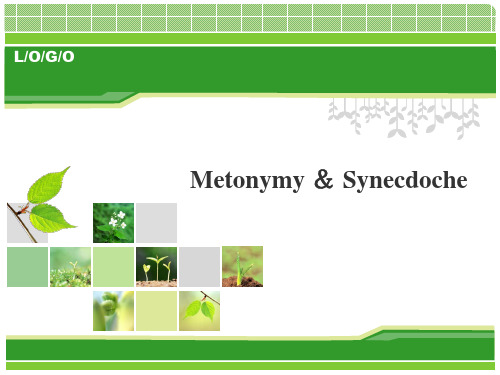
• Brain / head • Wisdom, intelligence, reason • Heart • Feelings, emotions
• Use your brains. • Her heart ruled her head.
2. name of a person as a name for his works or style 用作者代替作品
事物的特征代替人或物
• Those big noses, blue eyes and yellow hair taught them English.
• Foreigners who possess these features • 特征代本体: 即用借体(人或事物)的特征、标志
去代替本体事物的名称。
• The grey hair should be respected. • The grey hair --- The old / aged
• He is too fond of the bottles. • the bottle -- wine /alcohol
• What is learned in the cradle (摇篮) is carried into the grave.
• 两岸青山相对出,孤帆一片日边来《望天门山》 • 用船的一部分“帆”代替船。
修辞借喻

Rhetorical Devices
Metonymy and Synecdoche
Metonymy和Synecdoche的含义与形式 1.Metonymy译作“借喻” ,Synecdoche译作“提喻”。这两种辞格十分相近, 其共同点是不直接说出所指对象的名称,而采取某种替代形式;它们的区别 在于:metonymy是借与此相关某事物密切相关的东西来表示该事物,因此亦 称之为“借代”,而synecdoche是以某事物的局部表示整体,或反过来以整体 表示局部。例如人在幼年离不开摇篮。因而借用the cradle表示“婴几时期”, 这就是Metonymy: He must have been spoiled from the cradle. 又如:“头”和“手”等是人体的部分,用它们表示整个人常见的Synecdoche形 式; More hands (=working men) are needed at the moment. 2.注意这两种辞格与其他比喻形式之间的区别、试比较: Greece was the cradle of Western culture. (Metaphor) A bird in the hand is worth two in the bush. (Analogy)
1.They were short of hands. 2.My TV is out of order. 3.He could hardly earn his everyday bread. 4.The soldier is a valiant heart. 5.We had dinner at ten dollars a head. 6. Yet there were some stout heart who attempted resistance.
synecdoche and metonymy
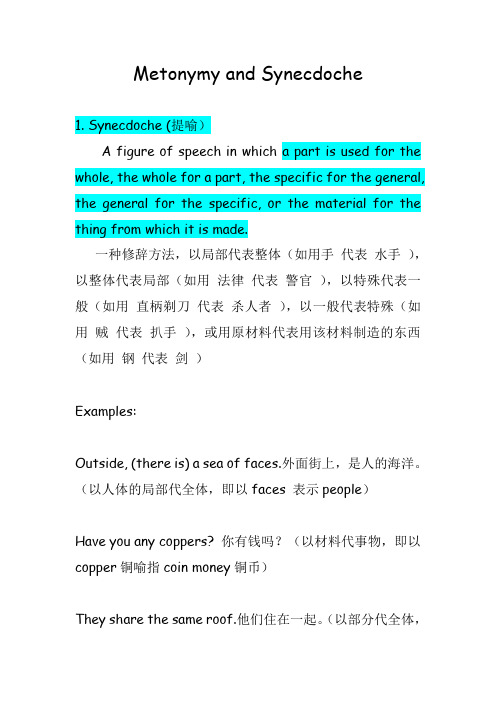
Metonymy and Synecdoche1. Synecdoche (提喻)A figure of speech in which a part is used for the whole, the whole for a part, the specific for the general, the general for the specific, or the material for the thing from which it is made.一种修辞方法,以局部代表整体(如用手代表水手),以整体代表局部(如用法律代表警官),以特殊代表一般(如用直柄剃刀代表杀人者),以一般代表特殊(如用贼代表扒手),或用原材料代表用该材料制造的东西(如用钢代表剑)Examples:Outside, (there is) a sea of faces.外面街上,是人的海洋。
(以人体的局部代全体,即以faces 表示people)Have you any coppers? 你有钱吗?(以材料代事物,即以copper铜喻指coin money铜币)They share the same roof.他们住在一起。
(以部分代全体,即用roof屋顶,表示house屋子、住宅)Lend me your ears (give me your attention).A fleet of ten sails \ To earn one’s bread \ To count headsThe poor man had twelve mouths to feed.2. Metonymy借代:A figure of speech in which one word or phrase is substituted for another with which it is closely associated, as in the use of “ Washington” for “the United States government” or of “the sword” for “military power”.借代的常用方法有:1.艺术家、作家人名代表其作品,如Picasso代表其画作2.动物名代表国家(人)或地区(人),如Bear代表俄国人3.地名、建筑代表机构或政府组织,如北京代表中国政府、Kremlin代表俄国政府等4.实物(特别是工具)代表其使用者、所有者或与之相关的某种概念。
英语 换喻 矛盾修辞 写作讲义

Metonymy和Synecdoche:Metonymy译作“换喻”,Synecdoche译作“提喻”。
这两种修辞格十分相近,其共同点是不直接说出所指对象的名称,而采取某种替代形式;它们的区别在于:metonymy是借与某事物密切相关的东西来表示该事物,因此亦称之为“借代”,而synecdoche是以某事物的局部表示整体,或反过来以整体表示局部。
例如人在幼年离不开摇篮,因而借用the cradle表示“婴儿时期”,这就是metonymy: He must have been spoilt from the cradle.又如:“头”和“手”等是人体的部分,用他们表示整个人,则是常见的synecdoche形式:More hands (=working men) are needed at the moment. We had dinner at ten dollars a head (=each person).注意这两种辞格与其他比喻形式之间的区别,试比较:Greece was the cradle of Western culture. –metaphorA bird in the hand is worth two in the bush. –analogy.Exercises:1.The grey hair should be respected.2.What is learned in the cradle is carried to the grave.3.The famous port used to be a harbor which was crowded with masts.4.“Einstein is my admiration,” the little girl said.Oxymoron:矛盾修辞法,例如cruel kindness, bitter-sweet memories等,修饰成分与被修饰成分内部看起来有矛盾,实则相反相成。
修辞——Metonymy,Synecdoche,Oxymoron,Alliteration

医生切开我的腹部,割除了阑尾,又把我 腹部缝好。 这是以me(我)代my abdomen(我的腹 部)。
蕴涵新意的Synecdoche(提喻)
3、以一种事物代替一类事物 Oh, the spring should vanish with the rose! That Youth’s sweet-scented manuscript should close! 哦,春天随着花儿的调零而消逝! 青年芬芳的书卷也要关闭。 这里用rose玫瑰代替flowers(花)。
Metonymy
A figure of speech in which one word or phrase is substituted for another with which it is closely associated, as in the use of Washington for the United States government or of the sword for military power. 一个词或词组被另一个与之有紧密联系 的词或词组替换的修辞方法.
蕴涵新意的Synecdoages to earn his bread. 他设法谋生。
蕴涵新意的Synecdoche(提喻)
4、用一类事物代替一种事物 Nearly 4.8 million vehicles rolled off the assembly lines, 20000 more than in 1988. 有近480万汽车开下生产线,比1988年多两 万辆。 此句以vehicle(交通工具)指代“汽车”。
笔要比剑更锋利
5.I am reading Lu Xun.我在读鲁迅的作品。
Metonymy & Synecdche

• It is a figure of speech that has to do with the substitution of the mane of one thing for that of another. • For instance, the pen (words) is mightier than the sword (forces). • 借代(metonymy)是指两种不同事物并不 相似,但又密不可分,因而常用其中一种 事物名称代替另一种。
7、Specific things instead of abstract things具体事物代替抽象事物 Soap and education are not as sudden as a massacre but they are made deadly in the long run .soap 指代沐浴, 讲卫生,而education 则指上学读书,接 收教育
Several years later, word came that Napoleony he himself was coming to inspect them... 几年以后,他们听说拿破仑要亲自来视察 他们。 “word”在这里代替了“news, information” (消息、信息) Al spoke with his eyes,“yes”. 艾尔用眼睛说,“是的”。 “说”应该是嘴的功能,这里实际上是用 眼神表达了“说话的意思”。
1. A part for the whole (以部分代整体) A girl of ten summers (years ) 十岁的女孩 The poor man had six mouths to feed (people ).这可怜的人要养六口人 The case had erupted round my head (my body ).这个案子就突然降临 到我头上了。 The poor man is now left without a roof(house ).这个可怜的人上无片 瓦。 He can’t ride a wheel (bicycle ).他不会骑自行车。 A thousand mustaches (men) can live together, but not four breasts (women). 一千个男人住在一起相安无事,但四个女人住在一起却争 吵不休。 There were some new faces(people) at the meeting.会上有些新面孔。
英汉翻译借喻和借代

借喻、借代;metonymy、synecdoche,antonomesia汉语中的借喻和借代借喻和借代都是隐去本体,只出现客体(喻体或借体)的辞格,因而容易混淆。
我们首先看下面的中文例子:1.我就知道,我们之间已经隔了一层可悲的厚障壁了。
(《故乡》2.花白胡子恍然大悟似地说…(《药》)句1中的“厚障壁”应是借喻,突出我们之间“隔阂”和“厚障壁”的相似性,句2中的“花白胡子”应是借代,用“花白胡子”来替代“留着花白胡子的人”,突出相关性。
区分时,我们可以看它们能否转成明喻的说法,还原本体,比如句1可以改为“…,我们之间的隔阂像一层可悲的厚障壁”,但句2不能说“留着花白胡子的人像花白胡子…”再如:3.燕雀安知鸿鹄之志哉?4.枪杆子里面出政权英文中的Metonymy和synecdoche首先我们来看一下英文词典中对两个词的解释:Metonymy: a figure of speech in which one word or phrase is substituted for another with which it is closely associated, as in the use of Washington for the United States government or of the sword for military power.(The American Heritage Dictionary of the English Language, Fourth Edition)Synecdoche:a figure of speech in which part is used for the whole(ashand for sailor), the whole for a part (as the law for police officer),the specific for the general (as cutthroat for assassin),the general for the specific(as thief for pickpocket), or the material for the thing made from it (as steel for sword). (The American Heritage Dictionary of the English Language, Fourth Edition)Metonymy 一词在《英汉辞海》中,解释为“换喻、转喻”,指用一个事物的名称去指代与它有关联的另一个事物。
Metonymy, synecdoche,antonomasia

Metonymy; synecdoche; antonomasia
Metonymy
synecdoche Metonymy
部分代 整体 整体代 部分 具体代 抽象 抽象代 具体 其中代 类属 类属代 其中
Antonomasia
comparison
原料代 其事物
Conclusion:
其实metonymy, synecdoche, antonomasia三者之间是 相互联系而又相互区别的,有学者将后两者并入 metonymy,其实也不完全正确。 我国的冯翠华教授说:”So long as we know the basic difference between them. What is important is that we know what they stand for.” 其实仔细比较之后我们仍然能够发现其中的一些区分 的方法:
王 丹
张 淑 变
刘 琰 华
高 超
曹 煜
王 书 婷
Very cup teammates
g{tÇ~ çÉâ4
英语修辞手法metonymy与synecdoche用法辨析
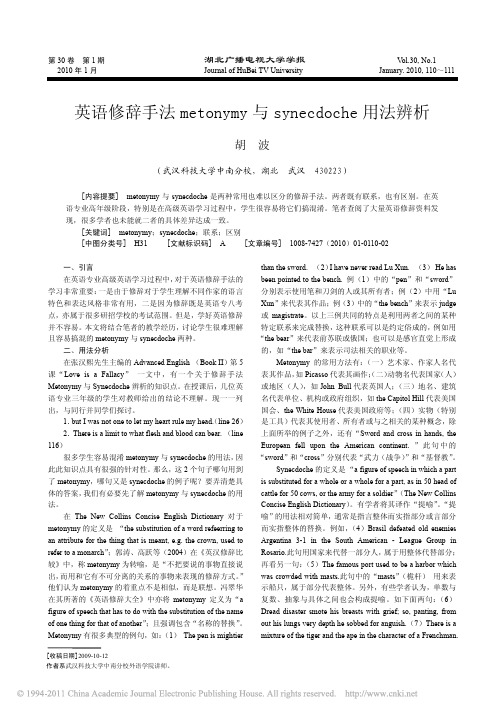
第30卷第1期湖北广播电视大学学报V ol.30, No.1 2010年1月 Journal of HuBei TV University January. 2010, 110~111 英语修辞手法metonymy与synecdoche用法辨析胡 波(武汉科技大学中南分校,湖北 武汉 430223)[内容提要] metonymy与synecdoche是两种常用也难以区分的修辞手法。
两者既有联系,也有区别。
在英语专业高年级阶段,特别是在高级英语学习过程中,学生很容易将它们搞混淆。
笔者查阅了大量英语修辞资料发现,很多学者也未能就二者的具体差异达成一致。
[关键词] metonymy;synecdoche;联系;区别[中图分类号] H31 [文献标识码] A [文章编号] 1008-7427(2010)01-0110-02一、引言在英语专业高级英语学习过程中,对于英语修辞手法的学习非常重要:一是由于修辞对于学生理解不同作家的语言特色和表达风格非常有用,二是因为修辞既是英语专八考点,亦属于很多研招学校的考试范围。
但是,学好英语修辞并不容易。
本文将结合笔者的教学经历,讨论学生很难理解且容易搞混的metonymy与synecdoche两种。
二、用法分析在张汉熙先生主编的Advanced English (Book II)第5课“Love is a Fallacy”一文中,有一个关于修辞手法Metonymy与Synecdoche辨析的知识点。
在授课后,几位英语专业三年级的学生对教师给出的结论不理解。
现一一列出,与同行并同学们探讨。
1.but I was not one to let my heart rule my head.(line 26)2.There is a limit to what flesh and blood can bear. (line 116)很多学生容易混淆metonymy与synecdoche的用法,因此此知识点具有很强的针对性。
转喻、提喻、换称三种修辞手法的对比

THE COMPARISON BETWEEN METONYMY,SYNECDOCHE AND ANTONOMASIA转喻、提喻、换称三种修辞手法的对比转喻(Metonymy)、提喻(synecdoche)、换称(antonomasia)这三种修辞手法都属于关系类修辞,它们的共同之处都是用某一事物的名称指代另一事物的名称,故而常常容易使人混淆。
目前国内有关英语修辞的教科书中就常将这三种修辞手法混为一谈,使得老师和学生对此模糊不清。
其实,如果将这三种修辞手法的定义和用法弄清,就不难区分它们。
下面就这三种修辞手法的定义、用法以及它们之间的异同等作些比较:一.转喻(Metonymy)的定义与用法:1.定义:用某一事物的名称代替另一事物的名称的修辞手法叫做转喻或借代。
这两种事物之间有着密切相关的联系。
(A metonymy is a figure of speech that has to do with the substitution of the name of one thing for that of another with which it is closely associated.)2.用法:转喻通常用下列几种方式指代:①根据人名或商品品牌名:Uncle Sam(山姆大叔)→Americans or the American government(美国人/美国政府)John Bull(约翰牛)→the English nation or a typical Englishman(英国/地道英国人)He is reading Shakespeare. 他在读莎士比亚作品。
Shakespeare's works (用作者指代作品)He went in debt just to keep up with the Joneses. 他为了与邻里攀比而负债。
neighbours(用“琼斯家”指代“邻里”)We drove a Ford to Hyde Park. 我们驾驶一辆福特牌小轿车到海德公园去。
英语修辞中的转喻(Metonymy)和提喻(Synecdoche)

提喻又称举 隅法 , 它起源于希 腊词“y ed ce , snk oh” 前缀
"
8n 意思为 “ gt r ,“k oh ” 思为“ae u ” 所 以 V" t e e” e d e 意 o h c tk p ,
“
tebr h a”来代替 “h ea Does n ;用 “rw ”代替 te l l r s o” g f i co n
“ig 或“ oe” 。 kn ” pw r等
12提 喻 的 基 本 内涵
“ e” b ss喻指 司机 “ ie ” 在这两 种修 辞中 , c vr 。 h s 本体不出现 , 而用与其相 近的喻体 , 使用通过联 想理解其含义 , 这样就
摘
要: 转喻 和提 喻 皆为名称代换的修辞手法 , 其共 同的修 辞特点是替换 和相近联 想。转喻 的替换模 式主
要 有人 体器官代替行 为或 能力等九种 ; 而提喻 的替换模 式主要 包括部分代整体等 五种 。 关键词 : 转喻 ; 提喻 ; 替换 ; 近联 想 ; 相 本体 ; 喻体
中图分 类号 : 35 H 1 文献标识码 : A 文章编号 :0 3—2 3 (0 6 0 10 14 2 0 )3—0 0 13—0 2
(h ooh n oi c ne) P ispyadSca S i cs l l e
Vo . 7 No 3 I2 .
Jn. 0 6 ue2 0
( n c oh ) S 英语修辞中的转喻( e nm ) M t y y和提喻 y ed c e o
费从荣
( 合肥工业大学 人文学 院 , 安徽 合肥 200 ) 30 1
英语中的metonymy和synecdoche
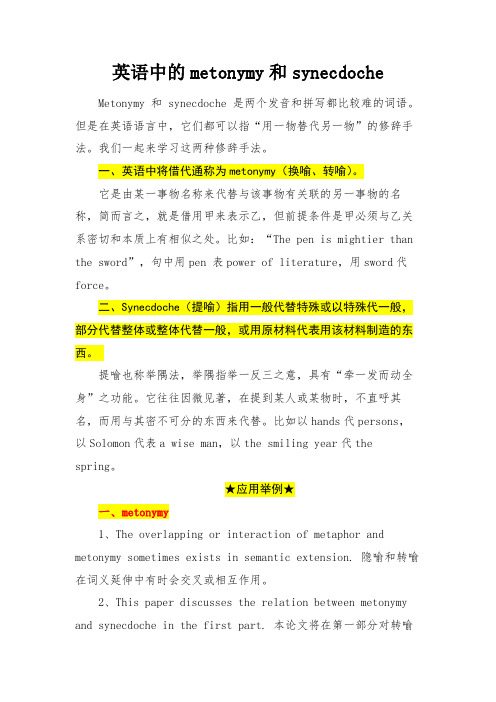
英语中的metonymy和synecdoche Metonymy 和 synecdoche 是两个发音和拼写都比较难的词语。
但是在英语语言中,它们都可以指“用一物替代另一物”的修辞手法。
我们一起来学习这两种修辞手法。
一、英语中将借代通称为metonymy(换喻、转喻)。
它是由某一事物名称来代替与该事物有关联的另一事物的名称,简而言之,就是借用甲来表示乙,但前提条件是甲必须与乙关系密切和本质上有相似之处。
比如:“The pen is mightier than the sword”,句中用pen 表power of literature,用sword代force。
二、Synecdoche(提喻)指用一般代替特殊或以特殊代一般,部分代替整体或整体代替一般,或用原材料代表用该材料制造的东西。
提喻也称举隅法,举隅指举一反三之意,具有“牵一发而动全身”之功能。
它往往因微见著,在提到某人或某物时,不直呼其名,而用与其密不可分的东西来代替。
比如以hands代persons,以Solomon代表a wise man,以the smiling year代the spring。
★应用举例★一、metonymy1、The overlapping or interaction of metaphor and metonymy sometimes exists in semantic extension. 隐喻和转喻在词义延伸中有时会交叉或相互作用。
2、This paper discusses the relation between metonymy and synecdoche in the first part. 本论文将在第一部分对转喻和提喻之间的关系进行论述。
3、On the basis of cognitive process, metonymy and conceptual integration theory may be closely related. 因此在认知过程研究的基础上,转喻与概念整合理论可以进行关联研究。
英语修辞手法metonymy and synecdoche
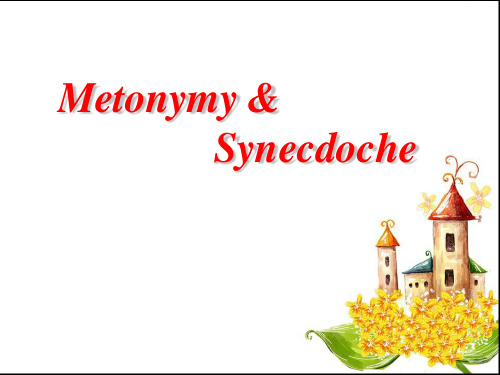
9. Controller for the controlled It was a great pity that Ozawa gave a terrible concert last night .
feet. • It is the nickname for Britain. England / the English people
Synecdoche
(提喻)
Definition
A figure of speech by which a part is put for the whole, the whole for the part, species for genus, the genus for the species or the name of the material for the thing made.
Ozawa 是交响乐队的指挥,而指挥是乐团的灵魂。因此,借Ozawa 之名 代他所指挥的交响乐队的全部演出,使其主要责任人一目了然
10、Concrete - Abstract Metonymy
(1) Concrete for Abstract The pen (words) is mightier than the sword (forces).
OI
What a despicable(可鄙的) creature he is! I do not like eat meat .
Metonymy & Synecdoche
英语中的metonymy和synecdoche
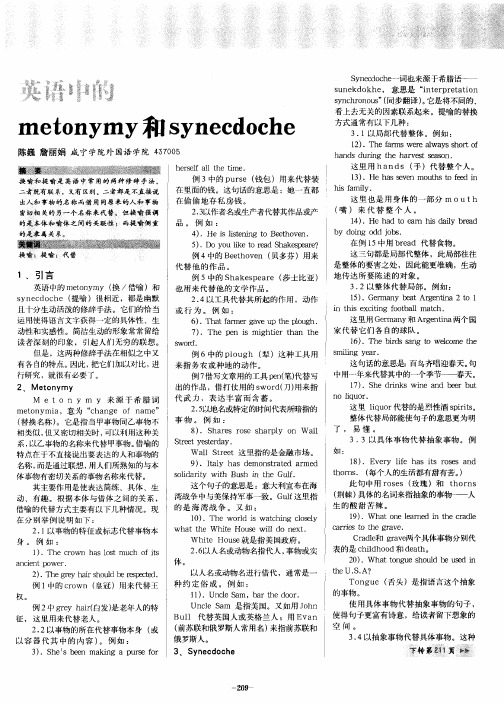
例 5中的 S k s e r ( ha ep a e 莎士比亚 ) 也用 来代替他的 文学作 品。 2. 4以工具代替其所起的作用 ,动作
或行 为 。例如 :
6 . h t a me a e p t epo g ) T a r rg v l h. f u h u
n q o. o l u r i
M y 来 源 于希 腊 词 e t0 n Y m
meo y a,意 为 “ h n e o a ” tn mi c a g f n me ( 替换名称 ) 。它是指 当甲事物同乙事物 不 相 类似 , 又密 切 相 关时 , 但 可以 利 用 这 种关
2. M e on m Y t y
这里 用 Gema y和 Are t a r n gni 两个 国 n 家代替 它们各 自的球队 。 1 ) T ebrssn owe o ete 6 . h i a g t l m h d c
s lgya. mi n e r i
例 6中的 p o g ( )这种工具用 lu h 犁 来指 务农或种地 的动 作。 例7 借写文章用的工具 pn 笔) e ( 代替写 出的作品 ,借打仗用的 s r ( 用来指 wo d 刀) 代武 力 ,表 达丰 富 而含 蓄 。 25 .以地名或特定的时间代表所暗指的 事物 。 例如 :
S n co h  ̄词也来源于希腊语一 y ed c e s n k o h , 意思是 “n e p e ain uedke i tr r tto snho os ( y c rn u ” 同步翻译) 它是将不 同的 、 。
meo y 和 s n c oh tn my y ed c e
转喻、提喻、换称三种修辞手法的对比

THE COMPARISON BETWEEN METONYMY,SYNECDOCHE AND ANTONOMASIA转喻、提喻、换称三种修辞手法的对比转喻(Metonymy)、提喻(synecdoche)、换称(antonomasia)这三种修辞手法都属于关系类修辞,它们的共同之处都是用某一事物的名称指代另一事物的名称,故而常常容易使人混淆。
目前国内有关英语修辞的教科书中就常将这三种修辞手法混为一谈,使得老师和学生对此模糊不清。
其实,如果将这三种修辞手法的定义和用法弄清,就不难区分它们。
下面就这三种修辞手法的定义、用法以及它们之间的异同等作些比较:一.转喻(Metonymy)的定义与用法:1.定义:用某一事物的名称代替另一事物的名称的修辞手法叫做转喻或借代。
这两种事物之间有着密切相关的联系。
(A metonymy is a figure of speech that has to do with the substitution of the name of one thing for that of another with which it is closely associated.)2.用法:转喻通常用下列几种方式指代:①根据人名或商品品牌名:Uncle Sam(山姆大叔)→Americans or the American government(美国人/美国政府)John Bull(约翰牛)→the English nation or a typical Englishman(英国/地道英国人)He is reading Shakespeare. 他在读莎士比亚作品。
Shakespeare's works (用作者指代作品)He went in debt just to keep up with the Joneses. 他为了与邻里攀比而负债。
neighbours(用“琼斯家”指代“邻里”)We drove a Ford to Hyde Park. 我们驾驶一辆福特牌小轿车到海德公园去。
- 1、下载文档前请自行甄别文档内容的完整性,平台不提供额外的编辑、内容补充、找答案等附加服务。
- 2、"仅部分预览"的文档,不可在线预览部分如存在完整性等问题,可反馈申请退款(可完整预览的文档不适用该条件!)。
- 3、如文档侵犯您的权益,请联系客服反馈,我们会尽快为您处理(人工客服工作时间:9:00-18:30)。
• He has a good ear for music.
• 他很懂得欣赏音乐。
• He has a sharp tongue.
• 他言辞尖锐。
2)name of a person as a name for his works or style 用作 者代替作品
• Will you play me some Chopin(肖邦)? • 你能为我弹奏几曲肖邦的音乐吗?
E.G.
crown --king the White House--the American government bottle--wine or alcohol
Classification
• 1) body part as a name for the sense,behavior or ability 用 人的感觉或其他部分代替作用或感觉 • 2)name of a person as a name for his works or style 用 作者代替作品 • 3)name of a cleaer sign of an object or a person as a name for the object or the person 用人或事物的特征代替 人或物 • 4)name of a place as a name for something produced or some event that happened there 用地方代替生产的 东西或那里发生的事件
Similarities and difference between Metonymy and Synecdoche
Comparison
• Metonymy 转喻 • A figure of speech in which one word or phrase is substituted for another with which it is closely associated, as in the use of ― Washington‖ for ―the United States government‖ or of ―the sword‖ for ―military power‖.
3)以一般代表特殊 The general for the specific • Nearly 4.8 million vehicles rolled off the assembly lines, 20000 more than in 1988.
• 有近480万汽车开下生产线,比1988年多两万 辆。 • 此句以vehicle(交通工具)指代“汽车”。
enterprises
用地点代替政府、机构、企业
• Downing street (唐宁街--英国首相官邸若干政府
主要部门的所在地)
• Buckingham (英国白金汉宫) • Pentagon (五角大楼)
Synecdoche(提喻)
Synecdoche(提喻)
• Definition
•
a type of figure of speech can be included in metonymy and it refers to the substitution in which the part stands for the whole, the whole for a part, the general for the specific, the specific for the general, the material for the thing made.
这里用rose玫瑰代替flowers(花)。 • He had to earn his daily bread by doing odd jobs. • bread -- food
5)用构成某东西的材料代表那样东西 the material for the thing made
• She was dressed in silks and satins (缎子). • Material for luxurious clothes
• 7)location as a name for ther government,institutions or
enterprises 用地点代替政府、机构、企业
1) body part as a name for the sense,behavior or ability 用 人的感觉或其他部分代替作用或感觉
• Those big noses,blue eyes and yellow hair taught them English. • 那些大鼻子,蓝眼睛,黄头发的人教他 们英语。
4)name of a place as a name for something produced or some event that happened there 用地方代替生产的东西或那里发生 的事件
• Have you ever read Jack Lomdon? • 你能为我读Jack London的小说吗?
3)name of a cleaer sign of an object or a person as a name
for the object or the person
物
用人或事物的特征代替人或
• Metonymy与Synecdoche之间是相互联系而又相互 区别的
• Similarities: • 广义的Metonymy,从其定义可以看出,是包含 Synecdoche在内的,也就是说Synecdoche是一种特 殊的Metonumy
例句分析:
• Do you like a cup or two? • cup指杯子,而例句中的cap指杯子里装的某种饮料, 它们之间的联系就是杯子用来装里面的饮料,这 肯定谈不上整体与部分的关系,所以是Metonymy
Metonymy Synecdoche用法讲解
第二组:刘佳慧、罗秋月、尹柯敏、夏嘉 悦、李娜、亓方圆
Metonymy(转喻)
LJH
Definition
• A figure of speech in which one word or phrase is substituded for another closely associated with it
Synecdoche 提喻 • A figure of speech in which a part is used for the whole, the whole for a part, the specific for the general, the general for the specific, or the material for the thing from which it is made.
手是人体的一部分,因此人们常用它来 代替各种各样的人。这里以 Hand(手) 代替 worker, laborer(工人)
• No eye saw him, but a second later every ear heard a gunshot.
• 没有人看见他。可是,一秒钟以后每个人都 听到了一声枪响。 • 此例是以人的部分的器官eye 或ear来代替人本 身。
Classification
1) 以局部代整体 part for whole
2) 以整体代局部 the whole for the part 3) 以一般代特殊The general for the specific 4) 以特殊代一般the specific for the general
5) 用构成某东西的材料代表那样东西 the material for the thing made
• 水开了。
• The hall applauded.
• 观众鼓掌。
6)trade mark or brand as a name for the products 用贸易标志、
商标代替产品
• He was driving a Ford.
• 他开着一辆福特。
7)location as a name for ther government,institutions or
• The famous port used to be a harbor which was crowded with masts( 桅 杆). • masts用来代表船只,属于部分代表整体,所以是 Synecdoche
• Spring should vanish with the rose! • rose替代花朵,部分代表整体,所以是Synecdoche
• The poor creature could no longer endure his sufferings. • Creature – man
4)以特殊代表一般 the specific for the general • Oh, the spring should vanish with the rose! • 哦,春天随着花儿的调零而消逝!
• Have you any coppers (铜)? • coin made of copper • 以coppers(铜)代 硬币(零钱)
6) 用抽象代实体或用实体代抽象the abstract for the concrete, or the concrete for the abstract • She has come to realize that life is not a bed of roses (a bed of roses 代替luxurious life and satisfied situation) • 她终于认识到人生并不是总是称心如 意。 • The gentleman in me made me stand up to go away, but the journalist in me made me stand still. • Gentleman---gentleman behavior • Journalist---objectivity and impartiality.
